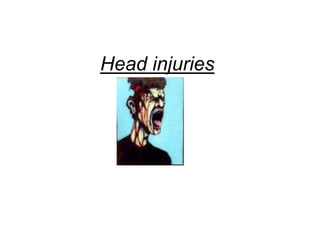
surgery.Head injury.(dr.ari)
- 4. • A head injury is any trauma that leads to injury of the scalp, skull, or brain. These injuries can range from a minor bump on the skull to a devastating brain injury.
- 5. • Head injury can be classified as either closed or penetrating. • In a closed head injury, the head sustains a blunt force by striking against an object • In a penetrating head injury, an object breaks through the skull and enters the brain. (This object is usually moving at a high speed like a windshield or another part of a motor vehicle.)
- 6. • Learning to recognize a serious head injury, and implementing basic first aid, can make the difference in saving someone's life. • In patients who have suffered a severe head injury, there is often one or more other organ systems injured. For example, a head injury is sometimes accompanied by a spinal injury.
- 7. Pathophysiology • Direct trauma. • Cerebral contusion. • Intracerebral shearing. • Cerebral edema. • I.C.H • Hydrocephalus
- 10. Cerebral Edema • Cellular response to injury – Primary injury – Secondary injury • Hypoxic-ischemic injury – Injured neurons have increased metabolic needs – Concurrent hypotension and hypoxemia – Inflammatory response
- 11. The main factors which determine the severity of cerebral injury are: • Distortion of the brain. • Mobility of brain in relation to skull and meninges. • Configuration of interior of skull. • Deceleration and acceleration. • The pre-existing state of brain (elderly).
- 14. The Secondary pathology: • Intracranial : – Brain swelling. – Necrosis. Ischemia. – Hematoma. – Vascular changes. – Coning. – Coup & Counter-coup.
- 15. • Extracranial : – Resp. failure, increase CO2. – Systemic B/P – Fluid, isotonic. – Temperature
- 16. • For a mild head injury, no specific treatment may be needed. However, closely watch the person for any concerning symptoms over the next 24 hours. • The symptoms of a serious head injury can be delayed. While the person is sleeping, wake him or her every 2 to 3 hours and ask simple questions to check alertness
- 17. • If a child begins to play or run immediately after getting a bump on the head, serious injury is unlikely. However, as with anyone with a head injury, closely watch the child for 24 hours after the incident.
- 18. • Signs of deterioration: – Becomes unusually drowsy – Develops a severe headache or stiff neck – Vomits more than once – Loses consciousness (even if brief) – Behaves abnormally
- 19. Skull fractures • Simple fracture. • Comminuted linear fracture of the vault. • Skull base linear fracture. • Depressed fracture. by: -falling objects. -Assault with a heavy blunt tool. -Missile injury. -R.T.A
- 21. • Compound depressed fracture: – Antibiotics. – Anti tetanus prophylaxis. – Surgery. Urgent. • Closed depressed fracture
- 22. Closed depressed fracture Indication of surgery: • Dural tear • Brain compression... (Dural venous sinuses.) • Compound. • Cosmetic.
- 23. Missile injuries: • Scalp injury. • Depressed skull fracture. • I.C.H. • Brain injury.
- 24. Management of Traumatic Head Injury • Maximize oxygenation and ventilation • Support circulation / maximize cerebral perfusion pressure CPP=MSP-ICP • Decrease intracranial pressure • Decrease cerebral metabolic rate
- 25. Monitoring • Serial neurologic examinations • Circulation / Respiration • Intracranial Pressure • Radiologic Studies • Laboratory Studies
- 26. Circulatory Support: Maintain Cerebral Perfusion Pressure 6 5 Number of 4 Good Hypotensive Moderate Episodes 3 Severe 2 Vegetative 1 Dead 0 Outcome Kokoska et al. (1998), Journal of Pediatric Surgery, 33(2)
- 27. Lowering ICP Brain Blood CSF Mass • Evacuate hematoma Bone • Drain CSF – Intraventricular catheters use is limited by degree of edema and ventricular effacement • Craniotomy – Permanence, risk of infection, questionable benefit
- 28. • Reduce edema • Promote venous return • Reduce cerebral metabolic rate • Reduce activity associated with elevated ICP
- 29. Management on head injuries • Minor head injury
- 30. Indications for admission to hospital: • Loss of consciousness. • Persistent drowsiness. • Focal neurological deficit. • Skull fracture. • Persisting nausea & vomiting • Elderly & infant. • W.
- 31. Management • Observation. • Bed elevated 20. • Mild fluid restriction.
- 32. Severe head injury • It depends on the patient’s neurological state and the intracranial pathology resulting from the trauma. • Clinical assessment and CT scan • Evacuation of any hematomas
- 33. • If there is no surgical lesion, or following the operation: – Observation and GCS chart – Decrease intracranial brain swelling • Airway management • Elevation of the head of the bed 20º • Fluid and electrolyte balance • Blood replacement with colloid or blood and not crystalloid • No steroids
- 34. – Management of conditions resulted from head injury • Severe hyponatraemia due to excessive fluid intake or inappropriate excessive secretion of ADH • Hypernatraemia due to inadequate fluid intake. • Diabetes insipidus
- 35. • Temperature control, pyrexia due to hypothalamic damage or traumatic SAH or infection or from CSF leak and meningitis
- 36. – Nutrition: • During the initial 2-3 days the fluid therapy will include 1.5-2 liters of 5% dextrose • After 3-4 days by nasogastric feeding
- 37. – Routine care of the unconscious patient, bowel, bladder and skin. – Intracranial monitoring in more severe cases.
